2016 JEEP GRAND CHEROKEE traction control
[x] Cancel search: traction controlPage 490 of 723
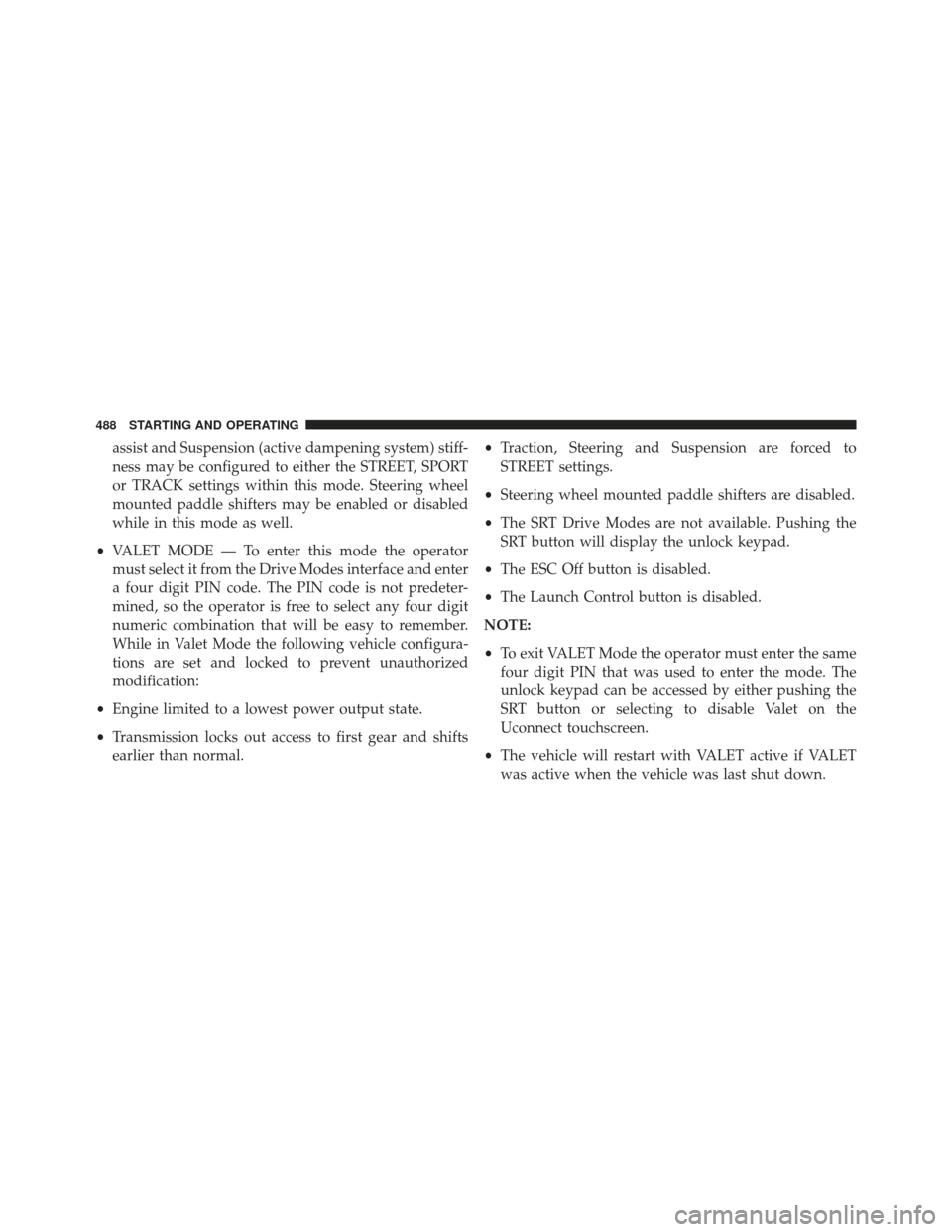
assist and Suspension (active dampening system) stiff-
ness may be configured to either the STREET, SPORT
or TRACK settings within this mode. Steering wheel
mounted paddle shifters may be enabled or disabled
while in this mode as well.
• VALET MODE — To enter this mode the operator
must select it from the Drive Modes interface and enter
a four digit PIN code. The PIN code is not predeter-
mined, so the operator is free to select any four digit
numeric combination that will be easy to remember.
While in Valet Mode the following vehicle configura-
tions are set and locked to prevent unauthorized
modification:
• Engine limited to a lowest power output state.
• Transmission locks out access to first gear and shifts
earlier than normal. •
Traction, Steering and Suspension are forced to
STREET settings.
• Steering wheel mounted paddle shifters are disabled.
• The SRT Drive Modes are not available. Pushing the
SRT button will display the unlock keypad.
• The ESC Off button is disabled.
• The Launch Control button is disabled.
NOTE:
• To exit VALET Mode the operator must enter the same
four digit PIN that was used to enter the mode. The
unlock keypad can be accessed by either pushing the
SRT button or selecting to disable Valet on the
Uconnect touchscreen.
• The vehicle will restart with VALET active if VALET
was active when the vehicle was last shut down.
488 STARTING AND OPERATING
Page 491 of 723
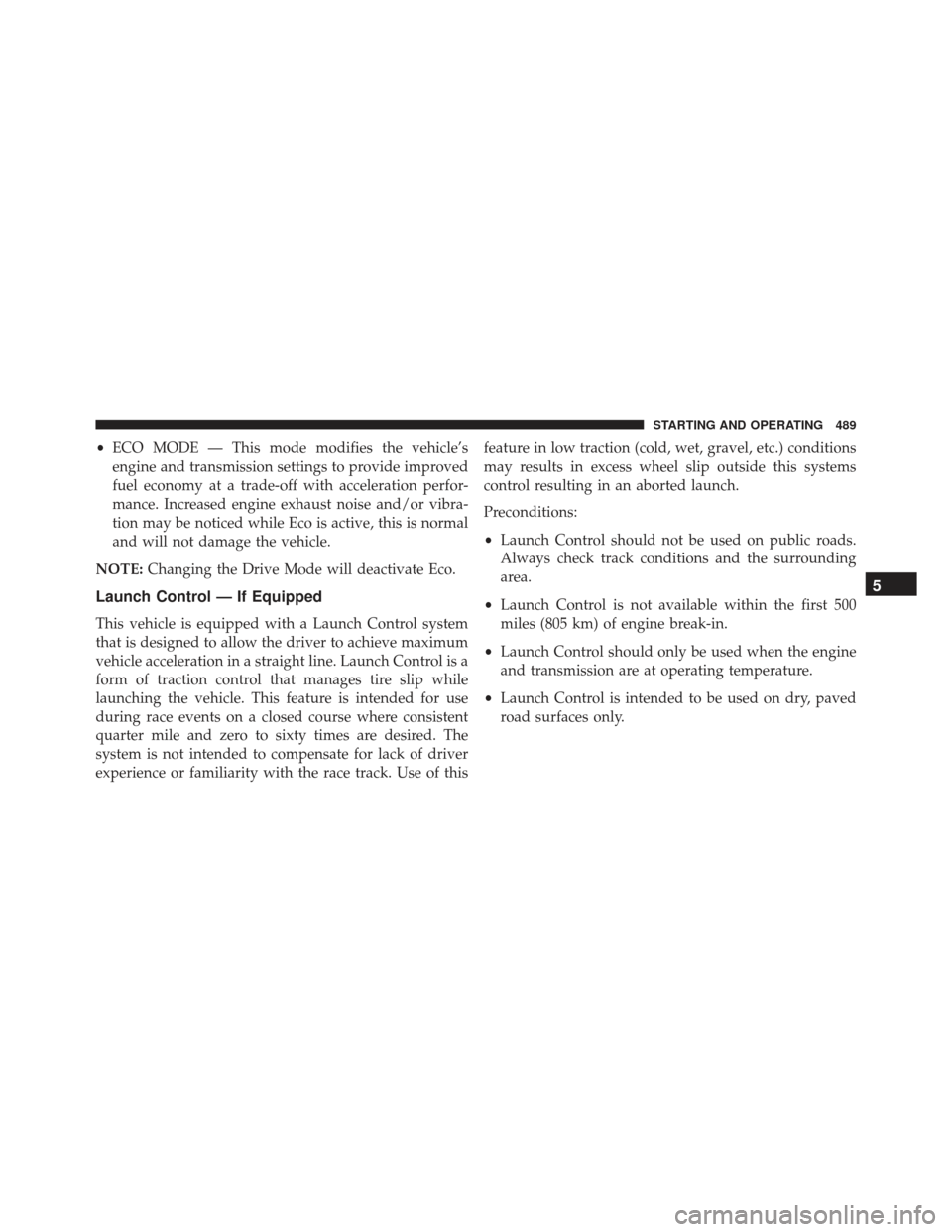
•ECO MODE — This mode modifies the vehicle’s
engine and transmission settings to provide improved
fuel economy at a trade-off with acceleration perfor-
mance. Increased engine exhaust noise and/or vibra-
tion may be noticed while Eco is active, this is normal
and will not damage the vehicle.
NOTE: Changing the Drive Mode will deactivate Eco.
Launch Control — If Equipped
This vehicle is equipped with a Launch Control system
that is designed to allow the driver to achieve maximum
vehicle acceleration in a straight line. Launch Control is a
form of traction control that manages tire slip while
launching the vehicle. This feature is intended for use
during race events on a closed course where consistent
quarter mile and zero to sixty times are desired. The
system is not intended to compensate for lack of driver
experience or familiarity with the race track. Use of this feature in low traction (cold, wet, gravel, etc.) conditions
may results in excess wheel slip outside this systems
control resulting in an aborted launch.
Preconditions:
•
Launch Control should not be used on public roads.
Always check track conditions and the surrounding
area.
• Launch Control is not available within the first 500
miles (805 km) of engine break-in.
• Launch Control should only be used when the engine
and transmission are at operating temperature.
• Launch Control is intended to be used on dry, paved
road surfaces only.
5
STARTING AND OPERATING 489
Page 492 of 723
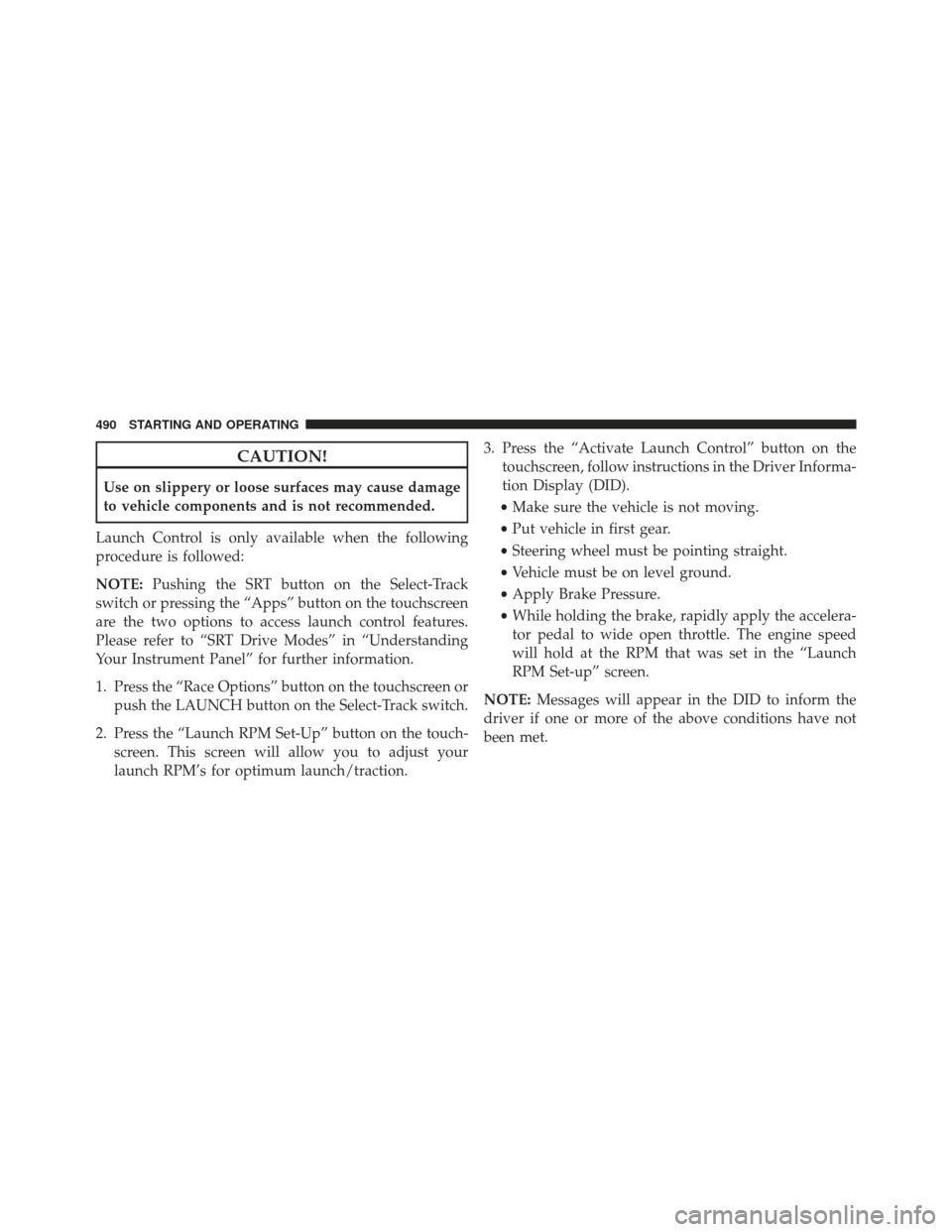
CAUTION!
Use on slippery or loose surfaces may cause damage
to vehicle components and is not recommended.
Launch Control is only available when the following
procedure is followed:
NOTE: Pushing the SRT button on the Select-Track
switch or pressing the “Apps” button on the touchscreen
are the two options to access launch control features.
Please refer to “SRT Drive Modes” in “Understanding
Your Instrument Panel” for further information.
1. Press the “Race Options” button on the touchscreen or push the LAUNCH button on the Select-Track switch.
2. Press the “Launch RPM Set-Up” button on the touch- screen. This screen will allow you to adjust your
launch RPM’s for optimum launch/traction. 3. Press the “Activate Launch Control” button on the
touchscreen, follow instructions in the Driver Informa-
tion Display (DID).
• Make sure the vehicle is not moving.
• Put vehicle in first gear.
• Steering wheel must be pointing straight.
• Vehicle must be on level ground.
• Apply Brake Pressure.
• While holding the brake, rapidly apply the accelera-
tor pedal to wide open throttle. The engine speed
will hold at the RPM that was set in the “Launch
RPM Set-up” screen.
NOTE: Messages will appear in the DID to inform the
driver if one or more of the above conditions have not
been met.
490 STARTING AND OPERATING
Page 493 of 723
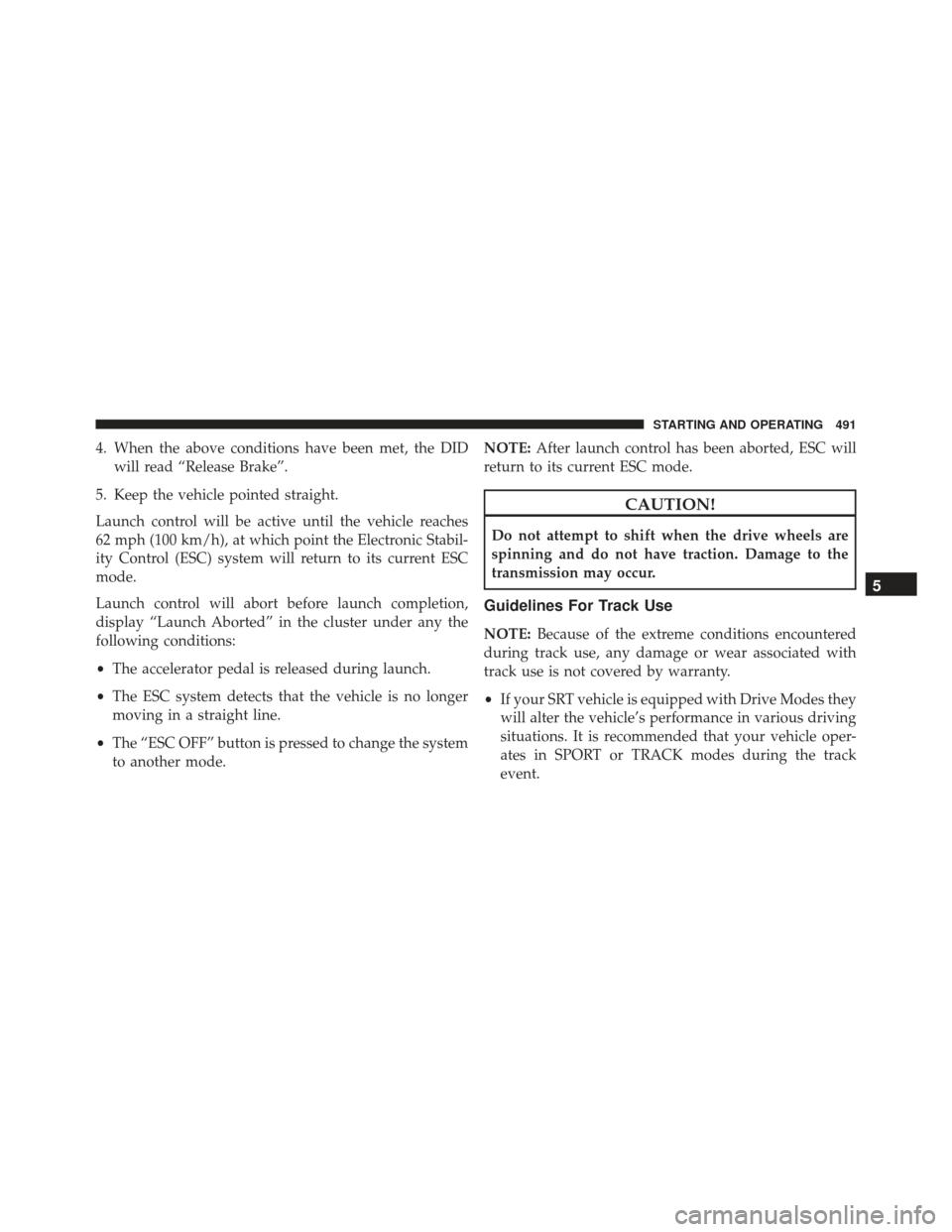
4. When the above conditions have been met, the DIDwill read “Release Brake”.
5. Keep the vehicle pointed straight.
Launch control will be active until the vehicle reaches
62 mph (100 km/h), at which point the Electronic Stabil-
ity Control (ESC) system will return to its current ESC
mode.
Launch control will abort before launch completion,
display “Launch Aborted” in the cluster under any the
following conditions:
• The accelerator pedal is released during launch.
• The ESC system detects that the vehicle is no longer
moving in a straight line.
• The “ESC OFF” button is pressed to change the system
to another mode. NOTE:
After launch control has been aborted, ESC will
return to its current ESC mode.
CAUTION!
Do not attempt to shift when the drive wheels are
spinning and do not have traction. Damage to the
transmission may occur.
Guidelines For Track Use
NOTE: Because of the extreme conditions encountered
during track use, any damage or wear associated with
track use is not covered by warranty.
• If your SRT vehicle is equipped with Drive Modes they
will alter the vehicle’s performance in various driving
situations. It is recommended that your vehicle oper-
ates in SPORT or TRACK modes during the track
event.
5
STARTING AND OPERATING 491
Page 503 of 723
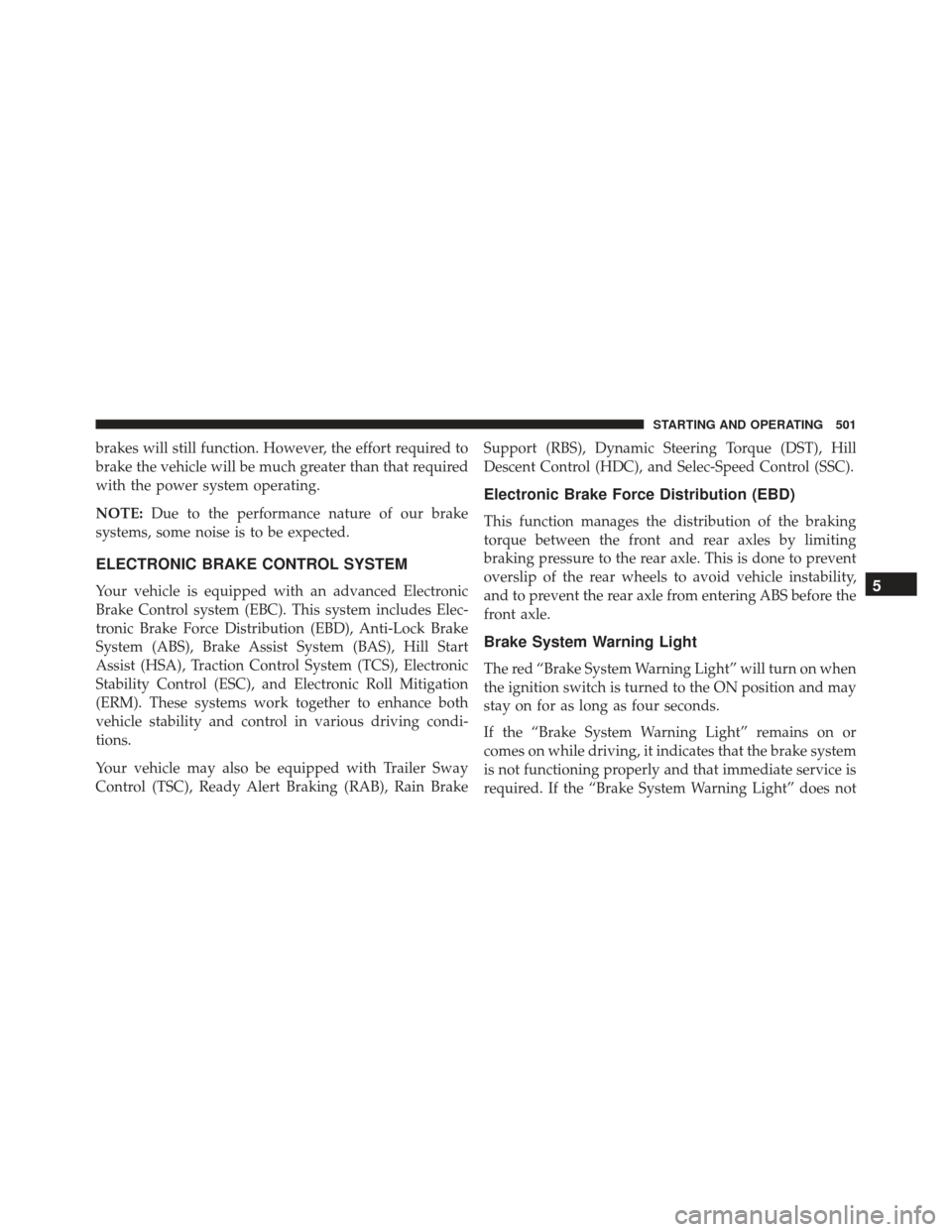
brakes will still function. However, the effort required to
brake the vehicle will be much greater than that required
with the power system operating.
NOTE:Due to the performance nature of our brake
systems, some noise is to be expected.
ELECTRONIC BRAKE CONTROL SYSTEM
Your vehicle is equipped with an advanced Electronic
Brake Control system (EBC). This system includes Elec-
tronic Brake Force Distribution (EBD), Anti-Lock Brake
System (ABS), Brake Assist System (BAS), Hill Start
Assist (HSA), Traction Control System (TCS), Electronic
Stability Control (ESC), and Electronic Roll Mitigation
(ERM). These systems work together to enhance both
vehicle stability and control in various driving condi-
tions.
Your vehicle may also be equipped with Trailer Sway
Control (TSC), Ready Alert Braking (RAB), Rain Brake Support (RBS), Dynamic Steering Torque (DST), Hill
Descent Control (HDC), and Selec-Speed Control (SSC).
Electronic Brake Force Distribution (EBD)
This function manages the distribution of the braking
torque between the front and rear axles by limiting
braking pressure to the rear axle. This is done to prevent
overslip of the rear wheels to avoid vehicle instability,
and to prevent the rear axle from entering ABS before the
front axle.
Brake System Warning Light
The red “Brake System Warning Light” will turn on when
the ignition switch is turned to the ON position and may
stay on for as long as four seconds.
If the “Brake System Warning Light” remains on or
comes on while driving, it indicates that the brake system
is not functioning properly and that immediate service is
required. If the “Brake System Warning Light” does not
5
STARTING AND OPERATING 501
Page 509 of 723
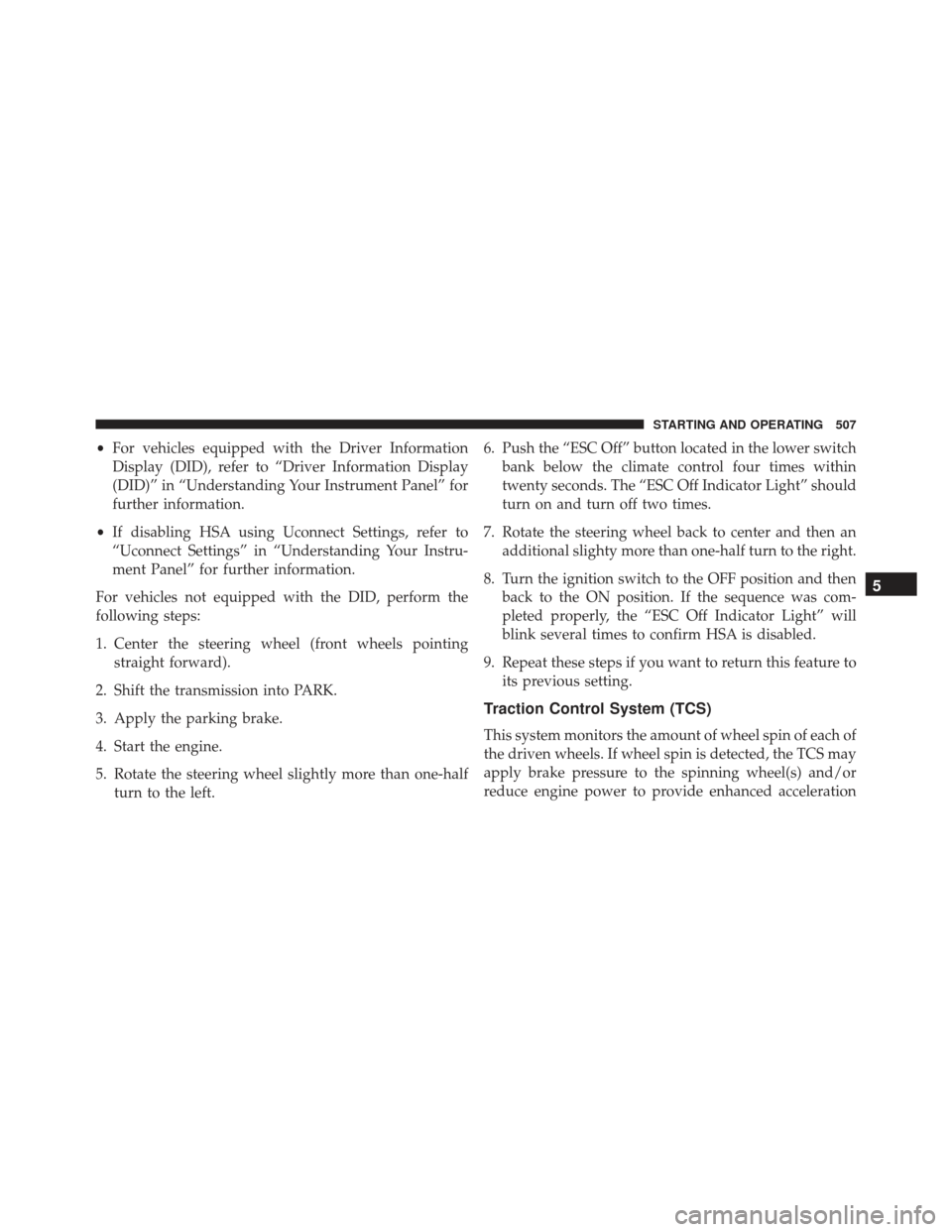
•For vehicles equipped with the Driver Information
Display (DID), refer to “Driver Information Display
(DID)” in “Understanding Your Instrument Panel” for
further information.
• If disabling HSA using Uconnect Settings, refer to
“Uconnect Settings” in “Understanding Your Instru-
ment Panel” for further information.
For vehicles not equipped with the DID, perform the
following steps:
1. Center the steering wheel (front wheels pointing straight forward).
2. Shift the transmission into PARK.
3. Apply the parking brake.
4. Start the engine.
5. Rotate the steering wheel slightly more than one-half turn to the left. 6. Push the “ESC Off” button located in the lower switch
bank below the climate control four times within
twenty seconds. The “ESC Off Indicator Light” should
turn on and turn off two times.
7. Rotate the steering wheel back to center and then an additional slighty more than one-half turn to the right.
8. Turn the ignition switch to the OFF position and then back to the ON position. If the sequence was com-
pleted properly, the “ESC Off Indicator Light” will
blink several times to confirm HSA is disabled.
9. Repeat these steps if you want to return this feature to its previous setting.
Traction Control System (TCS)
This system monitors the amount of wheel spin of each of
the driven wheels. If wheel spin is detected, the TCS may
apply brake pressure to the spinning wheel(s) and/or
reduce engine power to provide enhanced acceleration
5
STARTING AND OPERATING 507
Page 511 of 723
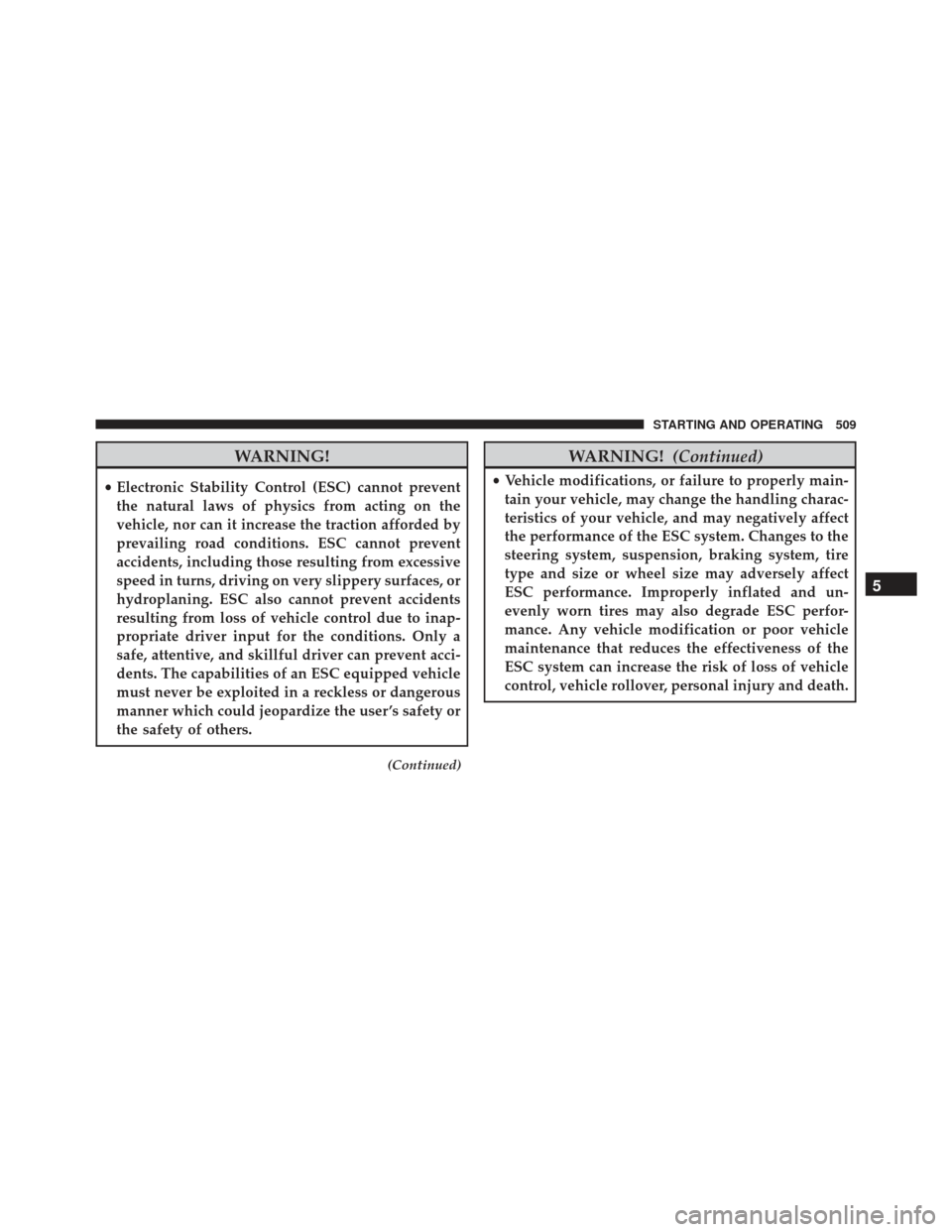
WARNING!
•Electronic Stability Control (ESC) cannot prevent
the natural laws of physics from acting on the
vehicle, nor can it increase the traction afforded by
prevailing road conditions. ESC cannot prevent
accidents, including those resulting from excessive
speed in turns, driving on very slippery surfaces, or
hydroplaning. ESC also cannot prevent accidents
resulting from loss of vehicle control due to inap-
propriate driver input for the conditions. Only a
safe, attentive, and skillful driver can prevent acci-
dents. The capabilities of an ESC equipped vehicle
must never be exploited in a reckless or dangerous
manner which could jeopardize the user ’s safety or
the safety of others.
(Continued)
WARNING! (Continued)
•Vehicle modifications, or failure to properly main-
tain your vehicle, may change the handling charac-
teristics of your vehicle, and may negatively affect
the performance of the ESC system. Changes to the
steering system, suspension, braking system, tire
type and size or wheel size may adversely affect
ESC performance. Improperly inflated and un-
evenly worn tires may also degrade ESC perfor-
mance. Any vehicle modification or poor vehicle
maintenance that reduces the effectiveness of the
ESC system can increase the risk of loss of vehicle
control, vehicle rollover, personal injury and death.
5
STARTING AND OPERATING 509
Page 514 of 723
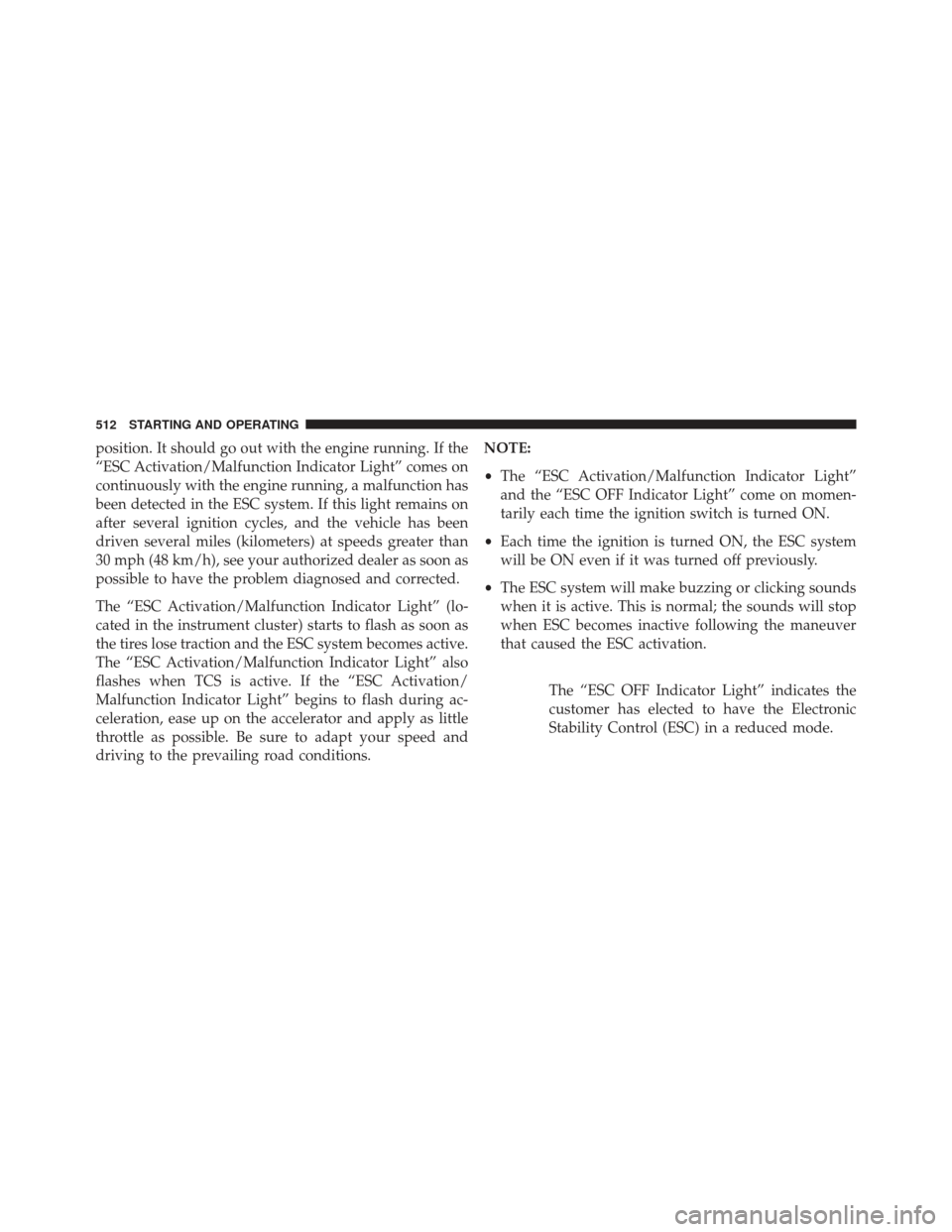
position. It should go out with the engine running. If the
“ESC Activation/Malfunction Indicator Light” comes on
continuously with the engine running, a malfunction has
been detected in the ESC system. If this light remains on
after several ignition cycles, and the vehicle has been
driven several miles (kilometers) at speeds greater than
30 mph (48 km/h), see your authorized dealer as soon as
possible to have the problem diagnosed and corrected.
The “ESC Activation/Malfunction Indicator Light” (lo-
cated in the instrument cluster) starts to flash as soon as
the tires lose traction and the ESC system becomes active.
The “ESC Activation/Malfunction Indicator Light” also
flashes when TCS is active. If the “ESC Activation/
Malfunction Indicator Light” begins to flash during ac-
celeration, ease up on the accelerator and apply as little
throttle as possible. Be sure to adapt your speed and
driving to the prevailing road conditions.NOTE:
•
The “ESC Activation/Malfunction Indicator Light”
and the “ESC OFF Indicator Light” come on momen-
tarily each time the ignition switch is turned ON.
• Each time the ignition is turned ON, the ESC system
will be ON even if it was turned off previously.
• The ESC system will make buzzing or clicking sounds
when it is active. This is normal; the sounds will stop
when ESC becomes inactive following the maneuver
that caused the ESC activation.
The “ESC OFF Indicator Light” indicates the
customer has elected to have the Electronic
Stability Control (ESC) in a reduced mode.
512 STARTING AND OPERATING